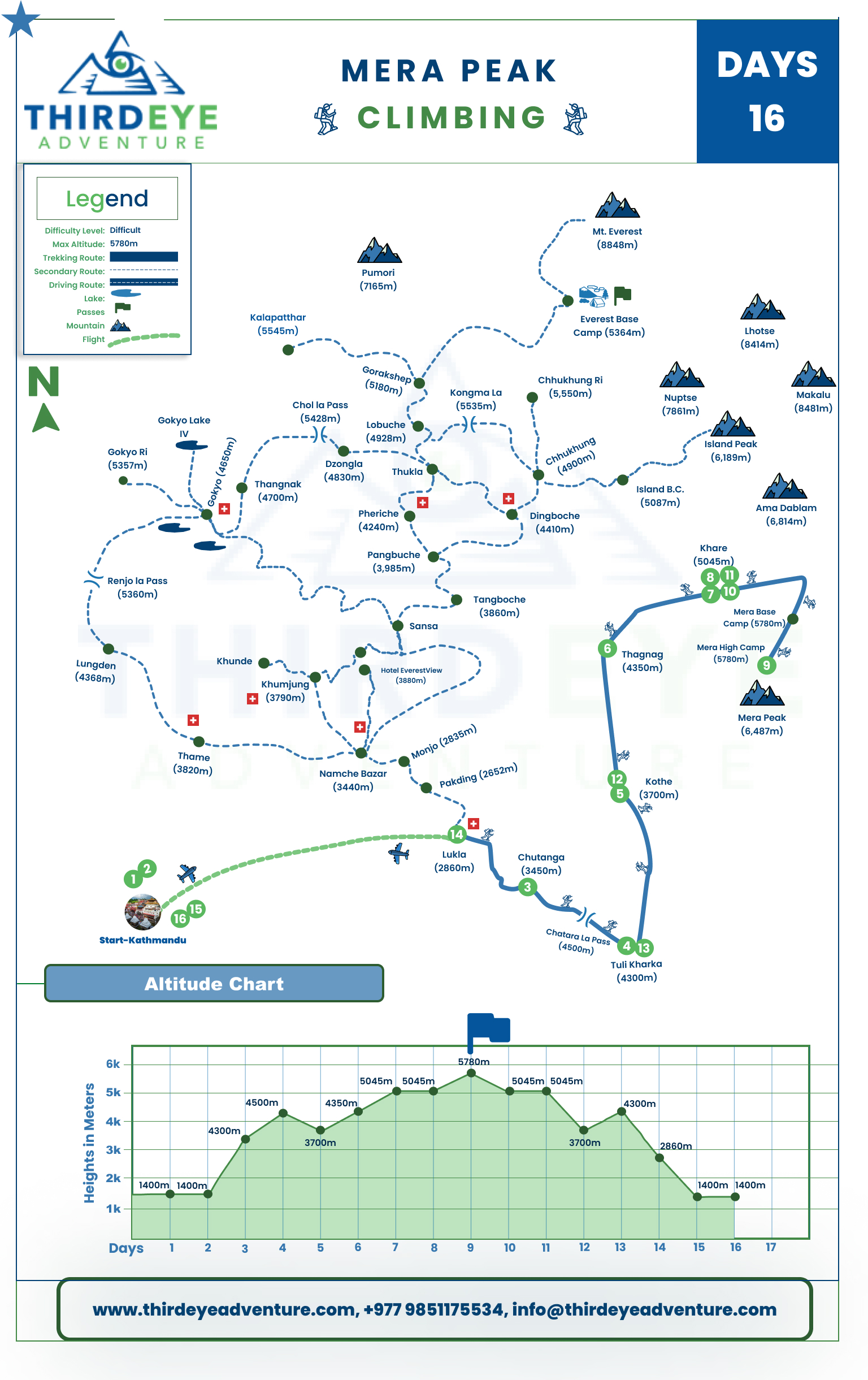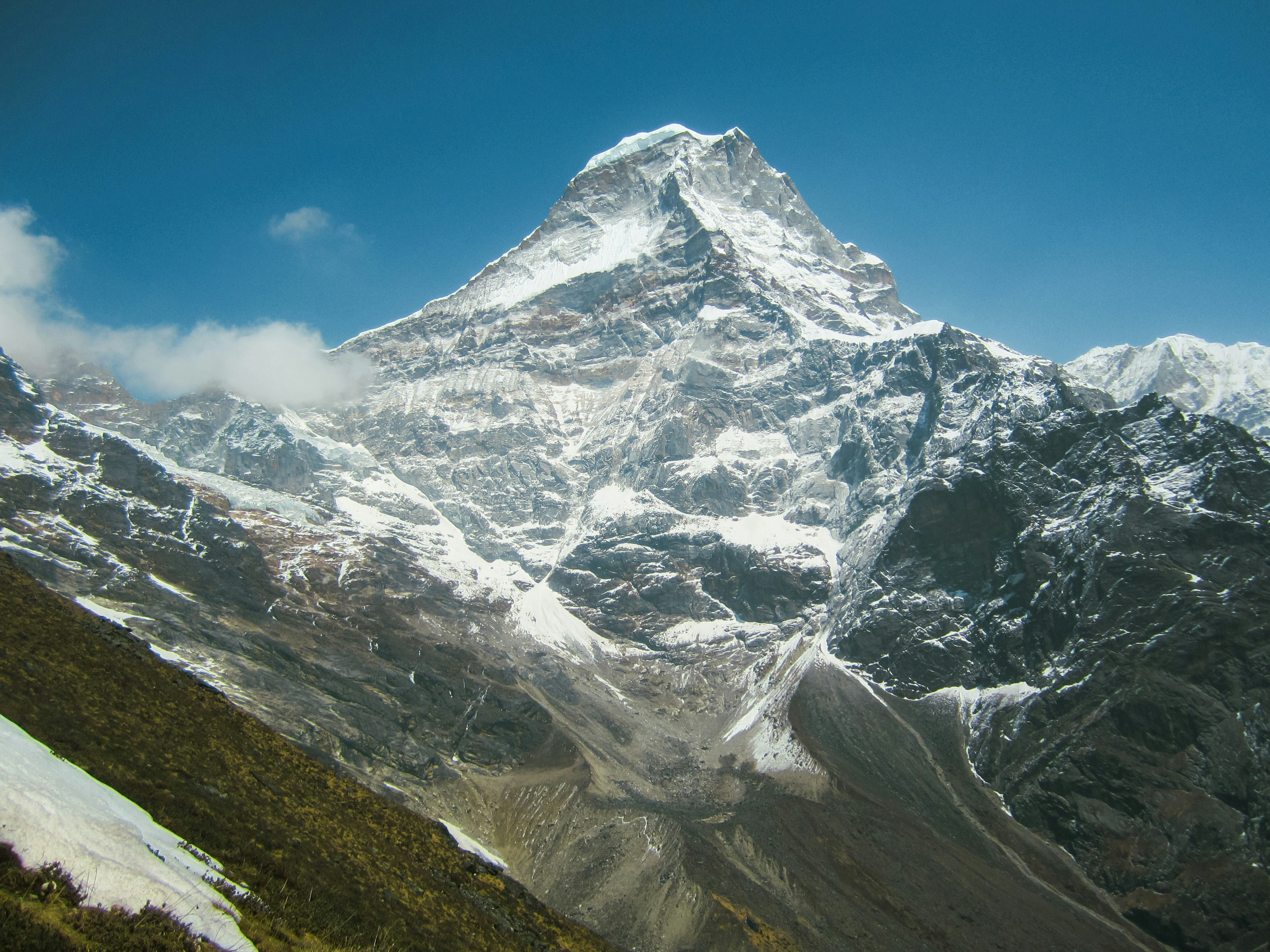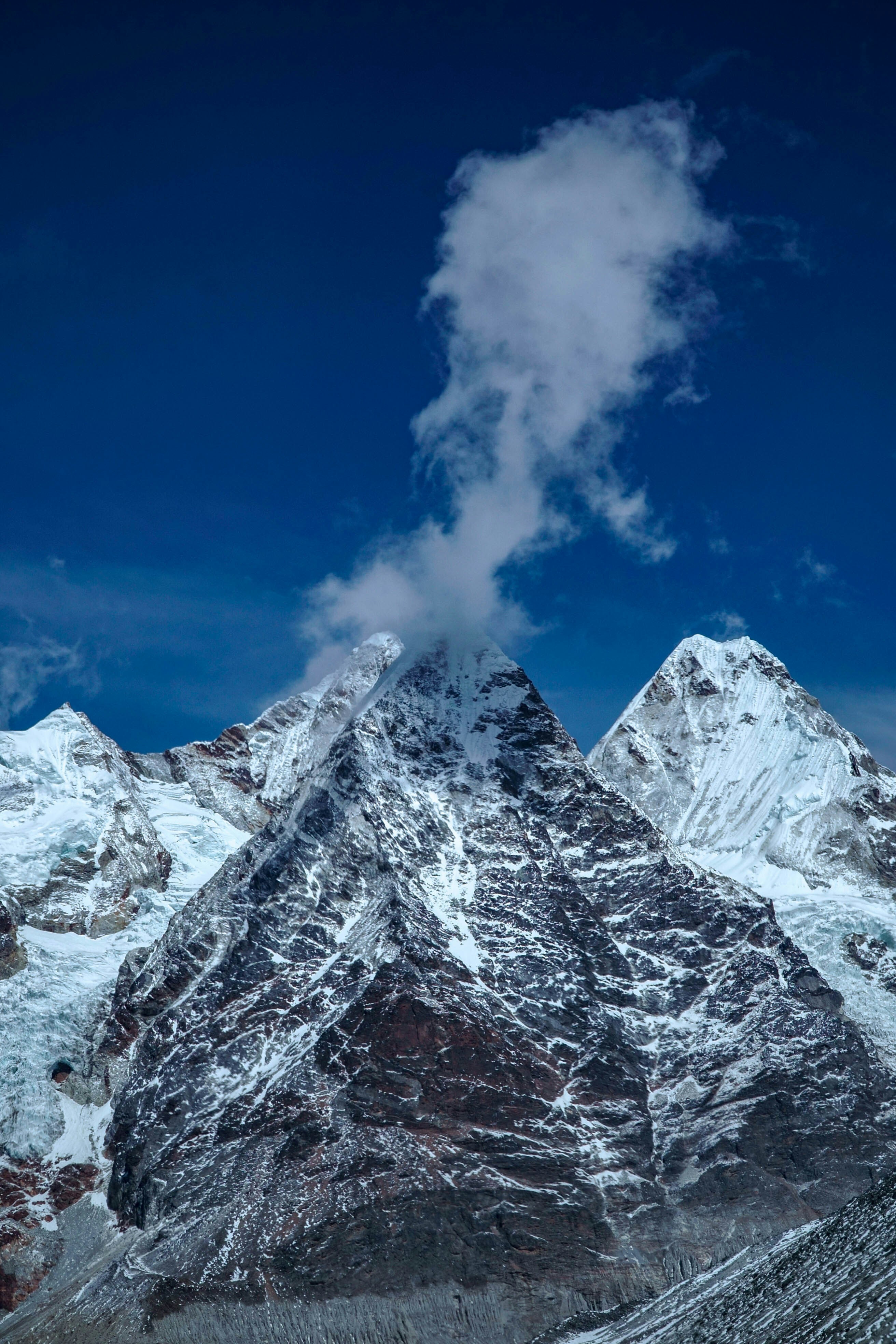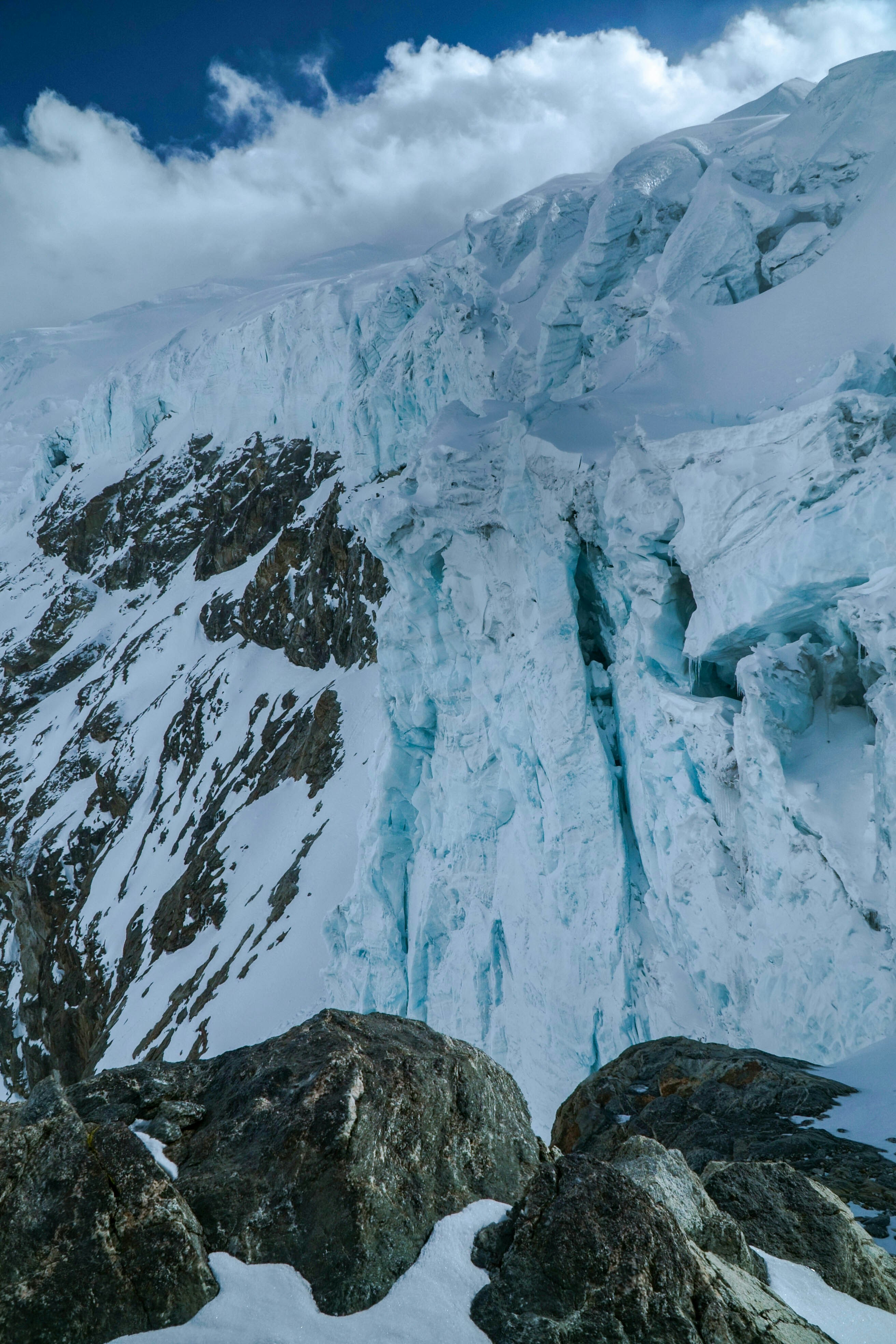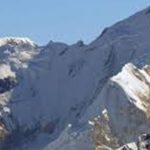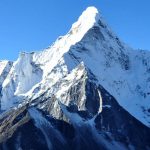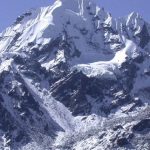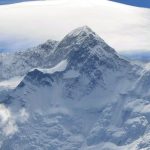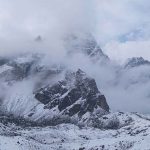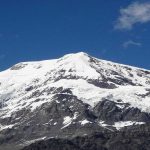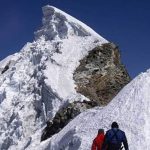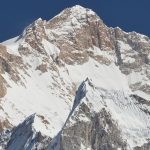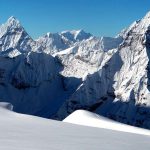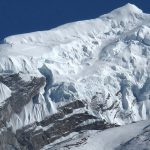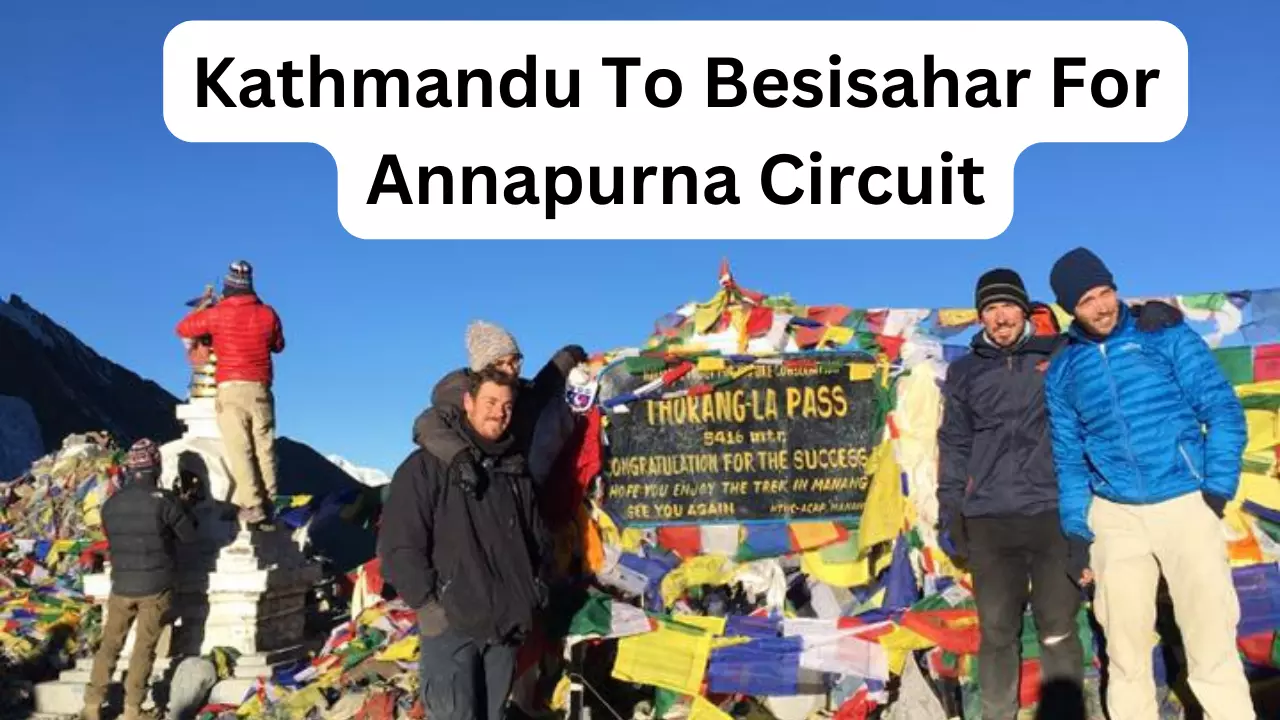
Mera Peak Trek Overview:
The Mera Peak is one of the most popular trekking peaks in Nepal, and it is popular for a good reason. Situated in the Everest Region, the peak lies at an altitude of 6,476 meters. The summit of the peak provides a breathtaking 360-degree view of the Himalayan range, including Mount Everest (8,848m), Mt Lhotse (8,586m), Mt Cho Oyu (8,201m), and Mt Makalu (8,643m).
In the Mera Peak trek, you will find everything you can imagine, such as unique Sherpa settlements, lush forests, swinging suspension bridges, and traditional gompas. There’s something for everyone to enjoy. And of course, you can’t forget about the prayer flags and stunning mountain views.
Whether you’re an experienced climber or just looking for an adventure, Mera Peak is the perfect destination. So what are you waiting for? Start planning your trip today!
Why Mera Peak is the perfect choice for beginners?
Mera Peak trek is ideal for those who want to enjoy a little bit of everything Nepal has to offer. From the stunning views of the snow-capped mountains to the different cultural monuments and settlements, you’ll be treated to a truly unique experience.
Climbing Mera Peak is the perfect choice for beginners for a number of reasons. First and foremost, it’s one of the tallest peaks in the world that is open to anyone who wants to submit it. That’s because the Nepalese government has made it a priority to make Mera Peak accessible to as many people as possible. In fact, they’ve even set up a base camp at the base of the peak that provides all the necessary amenities for climbers.
The feeling of accomplishment after summiting a Himalayan peak is beyond words. Our team of expert guides and porters will ensure that you have a safe and enjoyable trek. The trek is moderate in difficulty and can be undertaken by people of all ages.
During your trek, you’ll be overcome with joy however make sure to take some time to just breathe and take some beautiful photos. The landscape below is described by some as snowy, moon-like scenery. Of course, these moments of bliss cannot be possible without some exhausting (but rewarding) trekking.
The Mera peak is the perfect choice for those who wish to attempt a Himalayan summit for the first time. It is an achievable goal, with a well-defined trail and a comfortable base camp that makes it the ideal choice for beginners. Getting to the summit is a truly amazing experience, as the views are simply breathtaking.
Best Time For Mera Peak Trekking
Mera Peak trekking is a popular option for those looking to explore the Everest region. The best times to make the trips are during the spring (March to May) and autumn (September to November) seasons. These seasons provide the best weather and clearest skies. It is possible to climb in the winter, though the snow can pose difficult challenges. The key is to be prepared and to have the right gear.
Additionally, you should avoid traveling during the monsoon season (June to September), since heavy rains and landslides can make it impossible for you to travel.
Once you’re on the trail, the hardest part is the ascent to the summit. The trail is steep and strenuous, and altitude sickness is a real concern. Be sure to take your time and acclimatize to the altitude before making your final push to the top.
The rewards, however, are more than worth it. From the summit, you’ll be treated to some of the most incredible views on earth. Soak it all in, and enjoy the feeling of accomplishment that comes with reaching the top of one of Nepal’s most iconic peaks.
Trekking Map, Route & Accommodation To Mera Peak
The trekking route to Mera Peak starts from Lukla, which is a small town in the Everest region of Nepal. Trekking routes from Lukla take you through the Everest region, then onto Mera High Camp after the village of Khare. The trekking route to Mera Peak is a strenuous one and takes around 14 days to complete.
After a short 45 minutes flight from Kathmandu, you’ll find yourself in Lukla – the gateway to the world’s tallest mountain. During your visit to Lukla, you’ll be mesmerized by the beauty of your surroundings and can’t resist taking pictures. While it’s fun to take in the sights, you’ll need to prepare for the trek ahead.
After a relaxing night of sleep, you’ll make your way through Lukla to Chutanga. The trail leads you toward the edge of the forest, where you’ll find beautiful rhododendron and pine trees. You’ll pass through several small villages before you reach the thick woods on the slope beneath the Kalo Himal Ridge.
The next day, you’ll be greeted with spectacular views of Numbur Himal, Kongdi Ri, Karyolang, and numerous other mountains and peaks. You’ll spend the night at Chatara La, and the following day is just as adventurous. You’ll pass through woodlands of juniper, rhododendron, and other local vegetation. Enjoy the views of Mera and the Hinku Valley, and keep an eye out for wild animals like sloth bears and mountain cats among the tall pine trees.
As you trek for hours on your fifth and sixth days, you will reach your acclimatization day on the seventh. Today is another acclimatization day, which means you’ll be moving one day closer to your high peak. Get ready to walk around and prepare for the peak.
On your next day, you’ll be trekking from Khare to Mera High Camp. This is an energetic day, as you’ll be able to take in the spectacular views of Everest, Makalu, Baruntse, Kusum Kanguru, and many other mountains. Moreover, If you haven’t taken any pictures yet, make sure to have your camera ready as you make your way back to Khare from Mera High Camp.
The next few days will be spent enjoying the hospitality and sights of the villages you’ll be visiting on our way back. But eventually, your short trek will come to an end in Thuli Kharka. From there, you’ll make your way back to Lukla, where we’ll say goodbye and depart for Kathmandu.
When you book a trekking package with us, you can rest assured that your accommodation will be taken care of according to the itinerary you have selected. You’ll be staying in tea houses and hotels along the way, and we will provide you with guides and porters to make sure you have the best possible experience.
The food that is offered on our trekking packages is of the highest quality and is absolutely delicious. You’ll be able to choose from a variety of different dishes, and we’ll make sure that you’re well-fed and taken care of throughout your journey.
Tips for a Successful Mera Peak Climb
Mera Peak is Nepal’s most popular trekking peak and for good reason. At 6,476m it’s the highest trekking peak in the country and offers stunning views of some of the world’s tallest mountains, including Mt. Everest. It’s also a relatively non-technical climb, meaning that you don’t need any special mountaineering skills or equipment for the summit.
However, that doesn’t mean that climbing Mera Peak is easy. You’ll still need to be in good physical shape and be prepared for the altitude. Here are some tips to help you have a successful climb.
1. Choose the right time of year to go
The best times to make the trip, though, are during the spring (March to May) and autumn (September to November) seasons. These months offer the best weather conditions for trekking and climbing, with clear skies and moderate temperatures. Avoid the monsoon season (June to September), when heavy rains and landslides can make the trail impassable.
2. Get in shape
It is probably most important to remember that Mera Peak is only a moderate hike, so you will need to be in good physical shape to reach the summit. If you’re not used to hiking at altitude, start training a few months before your trip. Go for long hikes in the hills or mountains and try to do a few multi-day hikes. If you can, do some hikes with a backpack to get used to the extra weight.
3. Hire a guide
While it is possible to trek and climb Mera Peak without a guide, we highly recommend hiring one. As part of our package, you will receive a guide as well as porters to assist you throughout the trek. As a guide, you won’t only gain insight into the trail and technical sections of the climb, but also gain local knowledge and experience.
4. Stay hydrated & eat healthily
As your trek progresses to higher altitudes, it is extremely important that you stay hydrated and drink plenty of water. Be sure to drink enough water every day – at least 3-4 liters. You might not feel thirsty, but your body needs water to function properly.
On a similar note, it is important that you eat healthily throughout your trek. You’ll burn a lot of calories during your trek, so you need to replenish your energy. Don’t forget to eat plenty of carbs and protein throughout the day. Also, Snacks like nuts and bars are good choices for energy boosters.
5. Be prepared for the altitude
The altitude is one of the biggest challenges on the Mera Peak climb, so it’s important to be prepared for it. The best way to prepare for the climb is to acclimatize yourself. This involves gradually increasing your exposure to altitude over a few days or weeks. Symptoms of altitude sickness can include headache, nausea, vomiting, shortness of breath, and fatigue.
If you start to experience any of these symptoms, it’s important to descend to a lower altitude as soon as possible. In severe cases, altitude sickness can lead to edema (fluid in the lungs) or cerebral edema (fluid on the brain), which can be fatal.



